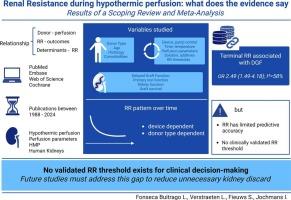Renal resistance during hypothermic machine perfusion: A scoping review of variability and determinants, with a meta-analysis of predictive value for transplant outcomes
IF 3.6
2区 医学
Q2 IMMUNOLOGY
引用次数: 0
Abstract
Background
Renal resistance (RR) measured during hypothermic machine perfusion (HMP) is used to assess donor kidney quality and guide transplantation decisions. However, its clinical reliability and relationship with donor factors remain unclear.
Methods
This scoping review and meta-analysis evaluate the variability, determinants, and predictive value of RR during HMP. A systematic search of PubMed, Embase, Web of Science, and Cochrane Library (July 2024) identified 49 primary studies reporting RR in perfused human kidneys. The risk of bias was assessed using the ROBINS-I tool. Meta-analyses for the predictive value of RR were performed when ≥3 studies reported univariable associations for the same time point and outcome.
Results
Most studies had moderate to serious risk of bias. RR typically declined rapidly, stabilizing within 5 h (range: 0.30–3.50 to 0.17–1.50 mmHg/mL/min), but patterns varied widely. Determinants included histology, donor characteristics, and perfusion additives, though evidence was inconsistent. A meta-analysis showed terminal RR was significantly associated with delayed graft function (odds ratio 2.49, 95 % CI 1.49–4.18, I2 = 58 %). While several studies proposed RR-thresholds, none were consistently validated, and heterogeneity in measurement timings and device settings limits comparability.
Conclusion
RR shows potential as a functional assessment parameter during HMP but is influenced by multiple technical and biological factors. Current evidence does not support the use of isolated RR-thresholds for organ acceptance. Standardized HMP protocols, trajectory modeling, and prospective studies are needed to clarify RR's role in clinical decision-making.

低温机器灌注期间的肾抵抗:变异性和决定因素的范围审查,移植结果预测价值的荟萃分析
背景:在低温机器灌注(HMP)期间测量肾阻力(RR)用于评估供体肾脏质量并指导移植决策。然而,其临床可靠性和与供体因素的关系尚不清楚。方法本综述和荟萃分析评估了HMP期间RR的变异性、决定因素和预测价值。对PubMed、Embase、Web of Science和Cochrane Library(2024年7月)的系统检索确定了49项报告灌注肾RR的主要研究。使用ROBINS-I工具评估偏倚风险。当≥3项研究报告同一时间点和结果的单变量关联时,对RR的预测值进行荟萃分析。结果大多数研究存在中度至重度偏倚风险。RR通常迅速下降,在5小时内稳定(范围:0.30-3.50至0.17-1.50 mmHg/mL/min),但模式差异很大。决定因素包括组织学、供体特征和灌注添加剂,尽管证据不一致。一项荟萃分析显示,终末RR与移植延迟功能显著相关(优势比2.49,95% CI 1.49-4.18, I2 = 58%)。虽然有几项研究提出了rr阈值,但没有一项得到一致的验证,而且测量时间和设备设置的异质性限制了可比性。结论rr有作为HMP功能评价参数的潜力,但受多种技术和生物学因素的影响。目前的证据不支持使用孤立的rr阈值进行器官接受。需要标准化的HMP方案、轨迹建模和前瞻性研究来阐明RR在临床决策中的作用。
本文章由计算机程序翻译,如有差异,请以英文原文为准。
求助全文
约1分钟内获得全文
求助全文
来源期刊

Transplantation Reviews
IMMUNOLOGY-TRANSPLANTATION
CiteScore
7.50
自引率
2.50%
发文量
40
审稿时长
29 days
期刊介绍:
Transplantation Reviews contains state-of-the-art review articles on both clinical and experimental transplantation. The journal features invited articles by authorities in immunology, transplantation medicine and surgery.
 求助内容:
求助内容: 应助结果提醒方式:
应助结果提醒方式:


